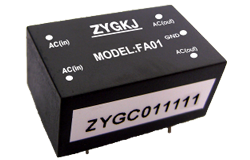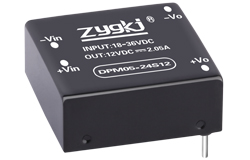նորություններ
Quality Control in DC-DC Converter Manufacturing: The Role of the Factory
Հեղինակ՝ ZYG Power Module Time: 2023-3-31
Quality control is an essential aspect of any manufacturing process, and DC-DC converter manufacturing is no exception. DC-DC converters are electronic devices that convert DC voltage from one level to another, and their quality is critical in many applications, including telecommunications, data centers, and medical devices. The role of the factory in ensuring the quality of DC-DC converters cannot be overstated, as they are responsible for implementing and monitoring quality control measures throughout the production process.
In this article, we will discuss the role of the factory in quality control in DC-DC converter manufacturing, including the measures they take to ensure that the products meet the highest quality standards.
Quality Control Measures in DC-DC Converter Manufacturing
The quality of a DC-DC converter depends on several factors, including the selection of components, design, assembly, and testing. The factory must ensure that each of these steps meets the required quality standards to produce a reliable and durable product.

Component Selection
The first step in ensuring quality is selecting the right components for the DC-DC converter. The factory must work with reputable suppliers and choose components that meet the required specifications. Components that do not meet the specifications can result in a faulty product, leading to increased failure rates and warranty claims.
Design and Assembly
The design of a DC-DC converter must be optimized for its intended application, and the assembly process must be carefully controlled to ensure consistency and reliability. The factory must follow a strict set of guidelines to ensure that the design and assembly meet the required standards.
Testing
The final step in quality control is testing the DC-DC converter to ensure that it meets the required specifications. The factory must perform various tests, including functional testing, electrical testing, and environmental testing, to ensure that the product is reliable and durable.
Role of the Factory in Quality Control
The factory plays a crucial role in quality control in DC-DC converter manufacturing. They are responsible for implementing and monitoring quality control measures throughout the production process to ensure that the products meet the highest quality standards.

The following are some of the roles that the factory plays in quality control in DC-DC converter manufacturing:
Implementing Quality Management Systems
The factory must have a robust quality management system in place to ensure that all processes are controlled and documented. This includes processes for component selection, design and assembly, and testing. The factory must also establish procedures for handling non-conforming products, including identification, quarantine, and disposition.
Conducting Quality Audits
The factory must conduct regular quality audits to ensure that the quality management system is working effectively. Audits can identify areas of improvement and help to prevent quality issues from occurring. Audits can also provide insight into the effectiveness of quality control measures and help to identify areas for improvement.
Supplier Quality Management
The factory must work closely with suppliers to ensure that the components they provide meet the required specifications. This includes establishing a supplier qualification process, conducting regular supplier audits, and ensuring that suppliers have adequate quality control measures in place.
Design and Assembly Control
The factory must ensure that the design and assembly process are controlled and consistent. This includes establishing clear work instructions, training employees, and monitoring the process for deviations. The factory must also have a process for identifying and correcting design or assembly issues that arise.
Testing and Inspection
The factory must conduct thorough testing and inspection to ensure that the products meet the required specifications. This includes functional testing, electrical testing, and environmental testing. The factory must also establish procedures for handling non-conforming products identified during testing and inspection.
Եզրակացություն
Quality control is critical in DC-DC converter manufacturing, and the factory plays a vital role in ensuring that the products meet the highest quality standards. The factory must implement and monitor quality control measures throughout the production process, including component selection, design and assembly.
համապատասխան տեղեկատվություն
-
2023-5-12
240V AC to 12V DC Converter manufacture
A 240V AC to 12V DC converter is an essential device that converts high voltage alternating current (AC) into low voltage direct current (DC). It is used in various electronic devices that require a low voltage power source, such as LED lights, Arduino boards, and other electronic devices. The converter is designed to take the input voltage of 240V AC and step down the voltage to 12V DC. This is achieved through a process called rectification and voltage regulation. The process involves converting the AC voltage to DC voltage through a diode and then using a voltage regulator to regulate the output voltage to a stable 12V DC. The 240V AC to 12V DC converter is commonly available in two...
Մանրամասնորեն -
2023-5-24
High-Efficiency Industrial AC-DC Converter for Reliable Power Conversion
Abstract: This paper presents the design and implementation of a high-efficiency industrial AC-DC converter for reliable power conversion. The proposed converter is based on a two-stage structure that includes a power factor correction (PFC) stage and a DC-DC stage. The PFC stage is implemented using a boost converter, while the DC-DC stage is implemented using a full-bridge converter. The proposed converter is capable of operating in a wide input voltage range and provides a regulated DC output voltage. Simulation and experimental results show that the proposed converter achieves high efficiency and meets the requirements of industrial applications. Introduction: In industrial applications, reliable power conversion is essential to ensure the stable operation of various equipment and systems. AC-DC converters are widely...
Մանրամասնորեն -
2023-4-23
Distinguishing Between AC and DC Power Supplies
AC and DC power supplies are two types of electrical power sources commonly used in various applications. AC stands for alternating current, while DC stands for direct current. The main difference between the two is the direction of the flow of electrons through the circuit. In this article, we will discuss the differences between AC and DC power supplies in terms of their characteristics, applications, and advantages. Characteristics of AC Power Supplies: AC power supplies provide electrical power that changes direction periodically. The voltage and current in an AC circuit oscillate sinusoidally, which means that they change direction and magnitude constantly. The frequency of this oscillation is measured in Hertz (Hz) and is typically 50 or 60 Hz in most...
Մանրամասնորեն -
2023-12-27
Module Power Supply: Ensuring Reliable and Efficient Energy Delivery
In today's technological world, where electronic devices are an integral part of our daily lives, the demand for reliable and efficient power supply has never been higher. Whether it's our smartphones, laptops, or even the complex machinery used in industries, all these devices require a stable and uninterrupted energy source. This is where module power supplies play a crucial role. In this article, we will explore the importance of module power supply and how it ensures reliable and efficient energy delivery. Understanding Module Power Supply: Module power supply refers to a compact electronic device that converts raw electrical power into the required form for various applications. It typically consists of an input stage, conversion stage, and output stage. The input...
Մանրամասնորեն -
2023-4-13
AC-DC փոխարկիչ՝ փոփոխական հոսանքի փոխակերպում ուղղակի հոսանքի
An AC-DC converter, also known as a rectifier, is an electronic device that converts alternating current (AC) to direct current (DC) by utilizing diodes or other semiconductor devices. This conversion is essential for many electronic devices that require DC power to function, such as computers, televisions, and radios. There are two main types of AC-DC converters: half-wave and full-wave rectifiers. A half-wave rectifier only allows one-half of the AC waveform to pass through, resulting in a DC voltage that is only half as large as the AC voltage. A full-wave rectifier allows the entire AC waveform to pass through, resulting in a DC voltage that is nearly equal to the AC voltage. In addition to diodes, AC-DC converters may also...
Մանրամասնորեն -
2023-8-11
Introducing the Powerful SP Series AC DC Converter
With the increasing demand for reliable and efficient power solutions, the SP Series AC DC Converter emerges as a powerful and innovative solution. This cutting-edge converter is designed to convert alternating current (AC) to direct current (DC) with high efficiency, making it an ideal choice for various applications. The SP Series AC DC Converter boasts an impressive range of features that set it apart from traditional converters. One of its key features is its high power density, which allows it to deliver a large amount of power in a compact and lightweight design. This makes it perfect for applications where space is limited but high power requirements are necessary. In addition to its remarkable power density, the SP Series AC...
Մանրամասնորեն


















